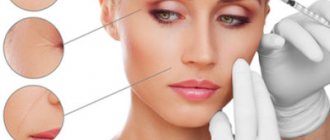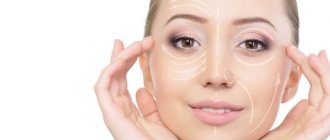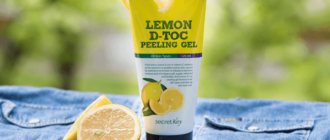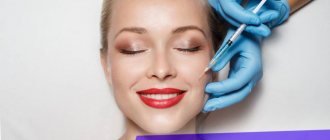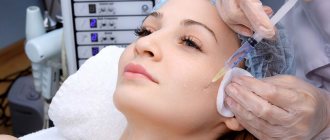- Department of Aesthetic Medicine
Department of Aesthetic Medicine » - Injection cosmetology
Injection cosmetology »
- Services
Services "
- Contour plastic
Contour plastic surgery is a modern injection technique that can be used to effectively eliminate wrinkles, increase the volume of lips or cheekbones, correct facial contours and emphasize the expressiveness of your appearance. Thanks to the safe and quick results , contouring has become one of the most popular procedures among women all over the world. At the RAMI Clinic, contour plastic surgery is performed using the latest generation gels, which are absolutely harmless, do not cause allergic reactions, rejuvenate, and give the skin a healthy color and beauty!
At the RAMI clinic, wrinkles are filled using filler based on hyaluronic acid. This substance is found naturally in the human body and is responsible for skin hydration and elasticity. During the injection of fillers, the missing volume is filled, the skin is lifted and smoothed out. The drug eliminates allergic reactions and the possibility of rejection, which happened with biopolymer gels. The results of wrinkle correction last from 6 to 10 months. In the postoperative period after correction of wrinkles with gel, swelling subsides within 2-3 days. On the fourth day, the patient returns to normal life and full social contacts.
FAQ
Q: What is better – contour plastic surgery or full-fledged plastic surgery?
A: Contour plastic surgery is a delicate, soft and atraumatic method of facial correction that can give an effect close to that of plastic surgery. It is not entirely correct to compare these methods. Their main difference is the duration of preservation of the result. Of course, in the case of invasive intervention it is much higher. Otherwise, the results of contour plastic surgery sometimes please patients even more than the results of plastic surgery.
Q: At what age is contour plastic surgery acceptable?
A: Corrective (modeling) contour plastic surgery is performed from adulthood. Anti-aging contour plastic surgery is recommended for patients of a mature age category (40-65 years). Until the age of 35-40, it is better to resort to preventive procedures - biorevitalization, mesotherapy, plasma lifting, etc.
Q: Is natural facial expression preserved after contouring?
A: Contour plastic surgery, in principle, does not involve the introduction of neurotoxins that relax facial muscles and stop the conduction of nerve impulses to muscle fibers. Therefore, facial expressions are preserved in full. With the artisanal and negligent work of a cosmetologist, the effect of a swollen “pillow face” is possible, but in order to avoid such a phenomenon, it is enough to be reasonable in choosing a specialist and not skimp on your own health.
Chin shape correction
Instead of mentoplasty - an operation to install cartilage or silicone implants in the chin area, fillers can easily change the shape of the chin - visually lengthen or widen it, hide imperfections. But lipolytic meso-cocktails, which break down accumulated fat while tightening the skin, will help get rid of a double chin.
Despite all the advantages, there are a number of contraindications:
- Under 18 years of age without guardian consent
- Pregnancy and lactation; Oncology
- Autoimmune diseases in acute form
- The final decision remains with the attending physician
- Inflammation of the skin at the injection site
- ARVI
- Tendency to form keloid scars
- Allergy to components of the products
- Bleeding disorders
For an ideal result and to avoid negative consequences, consultation with a competent specialist will help!
If side effects do not go away within 7 days, you should contact a cosmetologist who performed contouring.
Remember that you must approach the choice of a clinic and specialist with all responsibility.
Indications for facial contouring
Contour plastic surgery is performed when there are obvious signs of chronoaging of facial tissues:
- “Floating” oval of the face in the temporal, zygomatic and chin areas;
- Gravitational ptosis of the skin along the contour of the lower jaw;
- Age-related “jowls”;
- Double chin;
- Nasolabial and labiomental folds;
- Nasolacrimal grooves (“dips” in the malar zone, creating the visual effect of swelling of the lower eyelid);
- Deep wrinkles of surprise and anger on the forehead and bridge of the nose;
- Depletion of subcutaneous fat in the eyelids and cheeks.
The procedure is also used for:
- Creating or recreating seductive fullness of lips;
- Contouring the red border and lifting the corners of the mouth;
- Cheek lifts;
- Straightening the back of the nose with a hump or pits (no more than 3-5 mm in height or depth);
- Chin augmentation;
- Correction of the shape of the ears and earlobes;
- Neutralization of facial asymmetry and disproportions.
Non-surgical rhinoplasty
Instead of surgical rhinoplasty
Today, those with small humps and flat noses only need to spend half an hour visiting a cosmetologist to get the perfect profile. Fillers can smooth out unevenness and correct the shape: for example, make the bridge of the nose higher and thinner. Of course, only a plastic surgeon can make the nose significantly smaller or straighten a deviated septum for normal breathing. But if you are concerned about small aesthetic imperfections, we recommend that you first contact a cosmetologist. During a personal consultation, they will tell you what is best to do.
Preparations for contouring
Facial contouring involves the injection of special dermal (skin) implants with a gel-like consistency. All fillers differ in the concentration of the active substance, density and viscosity. The densest dermal implants are suitable for facial volumization and complex procedures such as non-surgical rhinoplasty. Fillers with a lighter structure are designed to fill skin creases, grooves and folds.
Modern fillers are divided into three categories according to the key component:
- Fillers based on hyaluronic acid are the most popular option, providing a harmonious and attractive correction result. Used both in youth and in adulthood. In addition to volumization, it provides deep and intense hydration of the skin at the dermal and epidermal level. This helps prolong the results of contouring by awakening the potentials of the skin;
- Fillers based on calcium hydroxyapatite have become increasingly popular in recent years. Like hyaluronic acid, calcium hydroxyapatite is constantly present in the human body, being part of bone tissue. Initially, fillers of this category were used to restore the volume of soft tissues in patients with AIDS. Having demonstrated excellent results in such complex cases, dermal implants have been introduced into aesthetic medicine. With their help, it is possible to model a clear and beautiful oval face. In addition, they have a lasting biological lifting effect, stimulating neocollagenesis;
- Polycaprolactone fillers are relatively new but well-researched dermal implants. They are based on a substance that has been used for a long time in general surgery as an absorbable suture material. A remarkable feature of the drugs lies in the record long preservation of the results of contour plastic surgery - up to 4 years. Currently, manufacturers are working on creating fillers that will retain their properties for 5-6 years.
Why is lip correction performed?
General indications for lip augmentation include:
- age-related changes;
- lip asymmetry;
- drooping corners of the mouth;
- loss of skin tone;
- wrinkles around the mouth;
- insufficient natural lip volume;
- loss of natural contour.
Wrinkles above the upper lip age the face of even young women. With age, the folds may lower and smooth out along with the central arch. The introduction of drugs allows you to restore the anatomical shape of the lips and restore the attractive contours of the face as a whole. In this article we will tell you what cosmetic products are used for lip augmentation, their features and administration techniques.
Choosing a filler for contouring
Fillers for contouring are selected by a cosmetologist during an in-person consultation, after a thorough diagnosis of the current skin condition, identification of specific problems, assessment of the patient’s wishes and expectations regarding the result of the procedure.
In modern practice, only high-quality and safe drugs from the world's leading manufacturers are used. The most popular of them are the Juvederm, Surgiderm, Restylane, Glytone and Princess families, as well as Radiesse and Ellanse. All dermal implants undergo multi-stage cleansing and are subsequently subjected to comprehensive independent research and testing.
The choice of drug depends on five factors:
- Type of aging (fine wrinkles, deformation or combined);
- The degree of age-related changes;
- The complexity of tasks related to modeling facial features;
- Patient's age;
- State of health (for example, fillers based on polycaprolactone are recommended for polyvalent allergy sufferers, since they do not contain animal and bacterial impurities).
In this case, the cosmetologist selects the drug according to three parameters:
- Key Ingredient;
- Concentration of the active substance and technology for cross-linking molecular bonds;
- Density and cohesiveness (viscosity).
Based on the collected data, the cosmetologist determines the most suitable filler in each individual case.
Protocol for contouring
Almost all fillers for facial contouring contain an anesthetic (lidocaine), which makes the procedure as comfortable as possible. If the patient wishes, the cosmetologist can provide additional application or injection (conduction) anesthesia.
Facial contouring is a simple and quick procedure, but for its high-quality execution, high professionalism and extensive experience of the cosmetologist are important. It is carried out according to the following algorithm:
- Control consultation and marking (optional);
- Pain relief (if provided);
- Opening the package with the drug and syringe/microcannula (done strictly in the presence of the patient);
- Carrying out a series of injections using a linear or fan-retrograde technique;
- Manual massaging of the treated areas for uniform distribution of the gel.
Rehabilitation after contouring involves avoiding thermal influences (baths, saunas, solariums, facial steaming) for 10-14 days. In the first 5-6 days, swelling, hyperemia and hematomas may persist. These side effects are temporary and are considered normal. They do not require treatment and go away on their own.
After contouring, the cosmetologist will give you recommendations regarding subsequent care.
In some cases, the procedure is “split” into several stages (visits) in order to avoid overcorrection.
Why hyaluronic acid?
Hyaluronic acid is the optimal remedy for lip augmentation, since it is natural for the body and has virtually no side effects.
Lip correction using hyaluronic acid injection takes no more than an hour and is carried out in stages. The cosmetologist immediately assesses the effect obtained and can take measures to achieve the desired result. Preparations containing hyaluronic acid are the safest for injection into the skin layers.
Benefits of hyaluronic acid fillers:
- quick cosmetic effect;
- rich natural lip color;
- moisturizing and nourishing the skin with beneficial elements;
- Possibility of lip augmentation at any age
- short recovery period, no complications;
- absence of scars after the procedure;
- lasting effect from one procedure throughout the year;
- smoothing of lip wrinkles;
- possibility of eliminating asymmetry.
The patient is allowed to use a mirror during the procedure to immediately evaluate the result and express wishes. In case of an error, it is enough to inject hyaluronidase. This substance accelerates the breakdown of the filler and returns the lips to their previous appearance. To ensure that the effect of lip augmentation lasts as long as possible, the drug can be administered repeatedly.
The disadvantages of the method include:
- painful manipulation;
- quite high cost;
- swelling for 1-2 days;
- the likelihood of herpetic rashes.
Contraindications to contour plastic surgery
- Chronic systemic and organic diseases in the acute stage;
- Decompensated endocrine pathologies;
- Fever;
- Viral dermatological diseases in the area of intended exposure (for example, herpes on the lip in the active phase);
- Malignant tumors;
- Coagulation disorders (hemophilia, thrombophilia, etc.);
- Pregnancy;
- Lactation;
- The presence of permanent implants in the area of intended impact (biopolymer gels, silicone implants).
Advantages and disadvantages of the procedure
Facial contouring has several significant advantages over other cosmetic rejuvenation and correction procedures, namely:
- comfort and absence of pain, thanks to the use of modern anesthesia;
- short duration of the procedure;
- minimal preparation and no side effects;
- almost instant effect;
- lasting results, which last in some cases up to 2 years after the first session;
- no rehabilitation period.
The main disadvantage of the procedure is its fragility. After time, all natural fillers tend to dissolve, then all skin imperfections will return to their previous state.
Duration of saving the result
The result of contouring appears instantly and is stable for 6-9 months. The duration of preservation of the result in each specific case depends on the chosen filler, conscientious adherence to recommendations and restrictions during the recovery process, individual characteristics of the body (metabolic rate, etc.).
Telephone consultation is always free!
Leave your contact, we will tell you everything and offer a discount!
Send
From the Negative side of the procedure.
In some cases, people may experience allergic reactions to synthetic compounds in injected medications. The professionalism of the cosmetologist also plays a big role in the final result.
Another negative side is the short-lived effect of the procedure. The results of its implementation are inconsistent; the filler is absorbed by the body only within 12-18 months. After this period, the effect of the drug completely disappears and patients require new injections.
Changing the shape of the eyelids
Since the skin of the eyelids is very thin and sensitive, it undergoes aging processes faster than other areas. Wrinkles in the form of “crow's feet” or “tear troughs” are a problem for most women, and their correction is carried out using fillers with varying degrees of viscosity.
The procedure lasts about an hour, there is no anesthesia before it. A few days before the procedure, patients should stop taking aspirin and not drink alcohol. Before and after eyelid contouring, you will have to avoid direct sunlight (for a certain period of time). The result is lasting and lasts up to a year.
